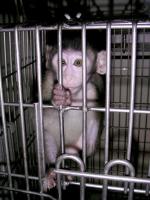In case people were unaware
of the horrific experiments that take place at Oxford on a daily basis,
here are some of the pointless and truly disturbing examples of the
type of experiments that will take place at the new animal research
centre should it ever be built on South Parks Road.

It is very difficult
to understand the mindset of people that are willing to inflict such
torture on animals, especially when nothing of value is garnered from
carrying out such experiments. It is up to each and everyone of us to
fight the battle against Oxford University and to stop their plans to
increase vivisection.
Please support SPEAK in its endeavours to rid the UK of all forms of
vivisection. It is only through your support that we can put an end
to a shameful part of the history of scientific research in this country
and indeed around the world. In an era of such scientific advancement
isn't it about time we started looking at scientific research of real
value rather than of one based on the most appalling cruelty to animals?
This is more akin to medieval torture centres rather than one based
on modern scientific practices.
-
The effect of cingulate cortex lesions on task switching and working
memory
The brain cortex of three 2-4 yr old macaque monkeys was removed
in order to see how this would affect their memory and their ability
to perform tasks requiring concentration. Researchers found that
the monkey which performed worst was the one that had suffered more
brain damage than the others, apparently because the researchers
had caused more extensive damage than they had intended. After the
experiment was completed, the animals were anaesthetised and their
blood supply flushed with formalin which is normally used to preserve
dead animals. The researchers concluded that there was a link between
the brain damage and the resulting impairment in the monkey's altered
behaviour patterns, but could not rule out the possibility that
other areas of the brain may have been responding to the experimental
injury and thus affected the outcome.
Funded by the Royal
Society, Medical Research Council
(UK) and the Wellcome Trust.
The effect of cingulate cortex lesions on task switching
and working memory. Dr.
Matthew Rushworth, Kristie
A Hadland (dead), Dr.
David Gaffan, Prof
Richard (Dick) E Passingham. Journal
of Cognitive Neuroscience 15:3, 338-353.
-
The regional cortical basis of achromatopsia: a study on macaque
monkeys and an achromatopsic patient
In an attempt to reproduce achromatopsia (loss of colour vision
in humans), six rhesus monkeys underwent major head surgery at the
Psychology Department of the University of Oxford to remove parts
of their skulls. Significant parts of their brain cortexes were
subsequently also removed. As

